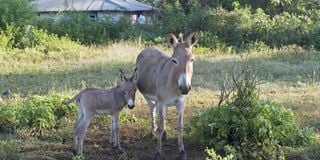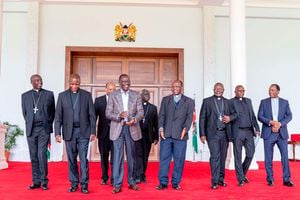Why breeding donkeys for slaughter won’t work
Sponsored by Brooke East Africa

Science dispels the idea that Kenya – or any other country – can breed enough donkeys for daily slaughter. Veterinary doctors, citing various scientific facts, say artificial breeding cannot produce donkeys fast enough to match the daily slaughter numbers.
Dr James Kithuka of Brooke East Africa and Dr Raphael Kinoti of Farming Systems Kenya say slaughtering donkeys in the hope that the country will breed more, is a mirage. Instead, this will soon lead to the extinction of the donkey in the country.
Because of the donkey’s peculiar reproductive habits, attempts to breed this domestic animal at the desired pace to satisfy slaughter demands have failed globally, the two observe.
They also note that trade in donkey skin – and not meat – is what drives the push to slaughter these animals daily.
Further, a spokesperson for The Donkey Sanctuary says: “Farming is an unrealistic solution for producing donkeys for the skin trade. The numbers needed to produce donkeys fast enough to match the daily slaughter numbers is unachievable.”
Dr Kithuka acknowledges that while “collecting semen from the male animal, processing it and inseminating the female of the same species with it is possible in science,” the success rate in donkeys is a disappointing 25 percent at the most. In cows, just to compare, the success rate of the process can go up to 90 percent.
“We have comprehensive knowledge on how to do timed artificial insemination in cattle, but not so on how to breed a donkey,” says Dr Kithuka.
Why is that so?
“Donkeys take long to release their eggs after the onset of standing heat (five to six days), and it is difficult to detect when actual standing heat started,” he explains. Standing heat is when the Jenny (female donkey) is receptive to a Jack (the male).
Dr Kinoti, the chief executive officer of Farming Systems Kenya, explains that donkeys are ‘hard breeders’ and do not breed well even under natural conditions, where the females and males are left to roam freely together.
“You can put them in huge areas (such as farms or sanctuaries), feed them well and give them water under free-range but in a year, less than 45 percent will be pregnant,” says Dr Kinoti.
He adds: “This is unlike horses which, if put under similar conditions, 65 to 70 percent of them will become pregnant, or even cattle, of which 80 to 90 percent of the cows will have conceived.”
Letting Jacks (male donkeys) run with the Jennies (female donkeys) on a restrictive farm is equally frustrating.
Dr Kithuka says China has tried Artificial Insemination (AI) on donkeys, unsuccessfully.
He notes that AI is the in-thing in the breeding of cows and enables farms and institutions to produce many animals within a short period using assisted reproduction technologies like embryo transfer. But it is difficult to achieve the same results in donkeys because collecting and processing their semen is a tough ask. “Donkey semen is delicate,” Dr Kithuka points out, saying after taking it through a normal AI process, most of it will not be viable.
A donkey’s gestation period is 12 months – a whole year. Moreover, twinning is almost zero in donkeys, meaning that a donkey will give birth to one foal after a year’s waiting.
The survival of the foal (young one of a donkey) is also not guaranteed as mortality of the newborn donkeys is over 10 percent in the wild and higher on farms. For every 100 foals born, 10 or more will die soon after birth. This is the highest mortality rate among livestock.
Should a foal survive, farmers face another challenge. The mother donkey is normally strongly attached to the young one for up to two years, during which period it cannot conceive.
“Donkeys,” says Dr Kinoti, “conceive and foal after an interval of three to five years.”
He cites figures from China to show that increasing a donkey population is not an easy task. “In 1996, China had 11 million donkeys (or a quarter of the world’s donkey population then) and by the end of last year, the population had declined to 3 million,” he says.
The vets emphasise that donkeys are free-range animals and keeping them under zero-grazing stresses them. They begin to develop a condition scientifically known as hyperlipaemia, or too much fat in the blood. This leads to organ failure and further compromises the ability of the donkeys to come on heat, thus reducing the chances of conception.
Donkey welfare organisations in Kenya say the sustainable solution remains in the wise decision many governments, including Kenya, have taken: Banning donkey skin trade.


